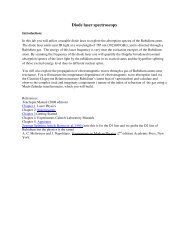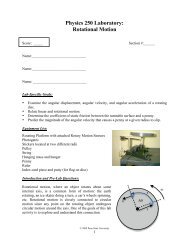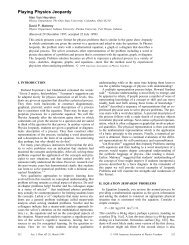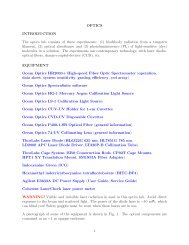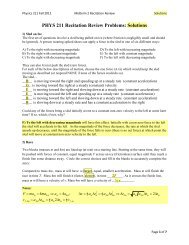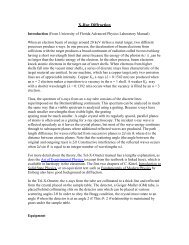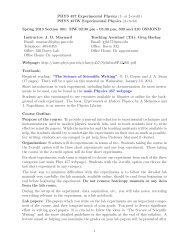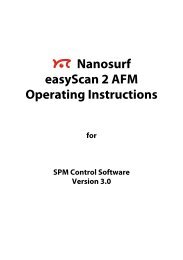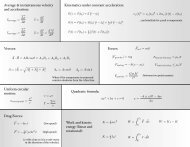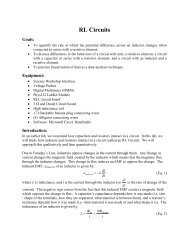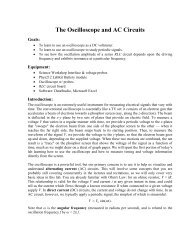Gauss' Law (Rec 4)
Gauss' Law (Rec 4)
Gauss' Law (Rec 4)
Create successful ePaper yourself
Turn your PDF publications into a flip-book with our unique Google optimized e-Paper software.
Gauss’ <strong>Law</strong><br />
NAME:<br />
NAME:<br />
NAME:<br />
RECITATION SECTION:<br />
INSTRUCTOR:<br />
DATE:<br />
____________________________________<br />
____________________________________<br />
____________________________________<br />
__________________________<br />
__________________________<br />
__________________________<br />
This activity is based on the following concepts:<br />
Electric flux through a surface is defined in the following way:<br />
o Divide the surface into small patches<br />
o Multiply the area of a patch by the component of the electric field in the direction<br />
perpendicular to the patch<br />
o Add the electric field contributions from all patches on the surface — that sum is the<br />
flux!<br />
o In practice, we will consider the patches to be infinitesimally small, and hence the<br />
sum is replaced by an integral.<br />
<strong>Gauss'</strong> <strong>Law</strong> is a fundamental law of nature that says:<br />
o The electric flux through any closed surface is equal to the total charge enclosed by<br />
that surface divided by ε 0 .<br />
o We write this mathematically as:<br />
Q<br />
E dA enc<br />
The electric field inside a metal (in electrostatic equilibrium) is zero!<br />
Some math that you must review:<br />
o What is the surface area of a sphere of radius R?<br />
o What is the volume of a sphere of radius R?<br />
o What is the surface area of a cylinder of length L and radius R?<br />
o What is the volume of a cylinder of length L and radius R?<br />
0
Exercise 1: Understanding Electric Flux<br />
The figures below show different surfaces in the presence of different electric fields. Determine<br />
the electric flux in each case, briefly showing your reasoning.<br />
15°<br />
E E <br />
Q1. <strong>Rec</strong>tangle of area A with a uniform electric<br />
field E oriented at an angle of 15° with respect<br />
to the normal to the surface of the rectangle.<br />
Flux:<br />
Q2. <strong>Rec</strong>tangle of area A with a uniform electric<br />
field E oriented parallel to the surface of the<br />
rectangle.<br />
Flux:<br />
E <br />
Q3. Spherical surface of radius R with an<br />
electric field pointing radially outward from the<br />
center of the sphere. The magnitude of the<br />
electric field at the surface of the sphere is<br />
everywhere E.<br />
Flux:
Exercise 2: Applying <strong>Gauss'</strong> <strong>Law</strong><br />
The figure at right shows a 2D cross-section of a charge<br />
arrangement containing a point charge +Q surrounded by an<br />
uncharged spherical metallic shell with inner radius R 1 and outer<br />
radius R 2 . Your goal is to use <strong>Gauss'</strong> <strong>Law</strong> to find out the magnitude<br />
of the electric field at the points A and B that are located at<br />
distances R A and R B from the center of the sphere as shown in the<br />
figure. You will also use <strong>Gauss'</strong> <strong>Law</strong> to determine the charge<br />
induced on the inner surface of the spherical shell. Remember to<br />
use the spherical symmetry of the problem in your arguments.<br />
B<br />
A<br />
R 1<br />
R 2<br />
+Q<br />
Q4. To determine the field at point A, draw a spherical Gaussian surface of radius R A , concentric<br />
with the point charge and metal shell.<br />
In terms of the electric field strength at A (E A ), and the radius R A , what is the electric flux<br />
through this surface? Use the definition of electric flux instead of Gauss’ <strong>Law</strong>.<br />
How much charge is enclosed by this Gaussian sphere?<br />
Using Gauss’ <strong>Law</strong>, and your expression for the electric flux at A, determine the electric<br />
field at point A.<br />
Q5. Another student in this class makes the following two claims:<br />
The charge on the inside surface of the spherical shell has to be −Q, and the<br />
charge on the outer surface of the shell is zero.<br />
Is this student correct in making both of these statements? You may want to use concepts such as<br />
(i) Gauss’ <strong>Law</strong>, (ii) the knowledge that E = 0 inside a metal in electrostatic equilibrium, (iii) the<br />
spherical symmetry of the problem, and (iv) the principle that charge must be conserved to<br />
convince us of what the correct answer should be. Be sure to address both statements.
Q6. Finally, determine the electric field at point B by imagining a spherical Gaussian surface of<br />
radius R B .<br />
In terms of the electric field at B (E B ) and the radius R B , what is the electric flux through<br />
this surface? Use the definition of electric flux instead of Gauss’ <strong>Law</strong>.<br />
What is the total charge enclosed by this surface?<br />
Using Gauss’ <strong>Law</strong>, determine the electric field at point B.



